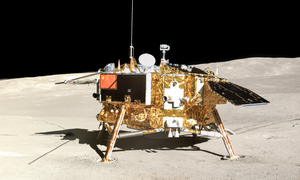Top: Chang'e 4 lander on the surface of the Moon Bottom: Yutu-2 rover on lunar surface. | |
| Mission type | Lander, lunar rover |
|---|---|
| Operator | CNSA |
| COSPAR ID | 2018-103A |
| SATCAT no. | 43845 |
| Mission duration | Lander: 12 months (planned) 2150 days (in progress) Rover: 3 months (planned) [1] 2150 days (in progress) |
| Spacecraft properties | |
| Launch mass | Total: 3,780 kg Lander: 3,640 kg [2] Rover: 140 kg[2] |
| Landing mass | Total: ~1,200 kg; rover: 140 kg |
| Dimensions | Rover: 1.5 × 1.0 × 1.0 m [3] |
| Start of mission | |
| Launch date | 7 December 2018, 18:23 UTC[4] |
| Rocket | Long March 3B[5] |
| Launch site | Xichang Satellite Launch Center, LA-2 |
| Lunar lander | |
| Landing date | 3 January 2019, 02:26 UTC [6] |
| Landing site | Spatio Tianhe[7] within Von Kármán crater[8] in the South Pole-Aitken Basin[9] 45°26′38″S 177°35′56″E / 45.444°S 177.599°E |
| Lunar rover | |
| Landing date | 3 January 2019, 02:26 UTC [10] |
| Landing site | Spatio Tianhe[7] within Von Kármán crater[8] in the South Pole-Aitken Basin[9] |
| Distance driven | 1.596 km (0.992 mi) as of 4 May 2024[update][11] |
Chang'e probes | |
Chang'e 4 (/tʃɑːŋˈə/; Chinese: 嫦娥四号; pinyin: Cháng'é Sìhào; lit. 'Chang'e No. 4') is a robotic spacecraft mission in the Chinese Lunar Exploration Program of the CNSA. It made a soft landing on the far side of the Moon, the first spacecraft to do so, on 3 January 2019.[12][13]
A communication relay satellite, Queqiao, was first launched to a halo orbit near the Earth–Moon L2 point in May 2018. The robotic lander and Yutu-2 (Chinese: 玉兔二号; pinyin: Yùtù Èrhào; lit. 'Jade Rabbit No. 2') rover[14] were launched on 7 December 2018 and entered lunar orbit on 12 December 2018, before landing on the Moon's far side. On 15 January it was announced that seeds had sprouted in the lunar lander's biological experiment, the first plants to sprout on the Moon. The mission is the follow-up to Chang'e 3, the first Chinese landing on the Moon.
The spacecraft was originally built as a backup for Chang'e 3 and became available after Chang'e 3 landed successfully in 2013. The configuration of Chang'e 4 was adjusted to meet new scientific and performance objectives.[15] Like its predecessors, the mission is named after Chang'e, the Chinese Moon goddess.
In November 2019, Chang'e 4 mission team was awarded Gold Medal by the Royal Aeronautical Society.[16] In October 2020, the mission was awarded the World Space Award by the International Astronautical Federation.[17] Both were the first time for any Chinese mission to receive such awards.
- ^ China says it will launch 2 robots to the far side of the Moon in December on an unprecedented lunar exploration mission Archived 9 December 2018 at the Wayback Machine. Dave Mosher, Business Insider 16 August 2018
- ^ a b Chang'e 3, 4 (CE 3, 4) Archived 20 March 2018 at the Wayback Machine. Gunter Dirk Krebs, Gunter's Space Page.
- ^ This is the rover China will send to the 'dark side' of the Moon Archived 31 August 2018 at the Wayback Machine Steven Jiang, CNN News 16 August 2018
- ^ "探月工程嫦娥四号探测器成功发射 开启人类首次月球背面软着陆探测之旅" (in Chinese (China)). China National Space Administration. Archived from the original on 10 December 2018. Retrieved 8 December 2018.
- ^ "Launch Schedule 2018". Spaceflight Now. 18 September 2018. Archived from the original on 10 September 2016. Retrieved 18 September 2018.
- ^ Barbosa, Rui (3 January 2019). "China lands Chang'e-4 mission on the far side of the Moon". NASASpaceFlight.com. Archived from the original on 3 January 2019. Retrieved 3 January 2019.
- ^ a b Cite error: The named reference
Xinhua-Spatio-Tianhewas invoked but never defined (see the help page). - ^ a b Cite error: The named reference
A&Swas invoked but never defined (see the help page). - ^ a b Cite error: The named reference
Overviewwas invoked but never defined (see the help page). - ^ Barbosa, Rui (3 January 2019). "China lands Chang'e-4 mission on the far side of the Moon". NASASpaceFlight.com. Archived from the original on 3 January 2019. Retrieved 3 January 2019.
- ^ "中国探月工程立项20年 回顾"嫦娥"奔月之旅" (in Simplified Chinese). 央视新闻. 4 May 2024. Retrieved 5 May 2024.
- ^ Lyons, Kate. "Chang'e 4 landing: China probe makes historic touchdown on far side of the moon". The Guardian. Archived from the original on 3 January 2019. Retrieved 3 January 2019.
- ^ "China successfully lands Chang'e-4 on far side of Moon". Archived from the original on 3 January 2019. Retrieved 3 January 2019.
- ^ Mosherand, Dave; Gal, Shayanne (3 January 2019). "This map shows exactly where China landed its Chang'e-4 spacecraft on the far side of the moon". Business Insider. Archived from the original on 4 January 2019.
- ^ Notably, the rover was modified "to meet the demands of the far-side terrain, but also to avoid the fate of the robot's predecessor, which became immobilized after driving only 360 feet (110 meters)" Pearlman, Robert Z. (12 December 2018). "China's Chang'e 4 Moon Lander and Rover to Touch Down As Toys". Future US, Inc. Archived from the original on 13 August 2023. Retrieved 15 November 2019.
- ^ "Plane Speaking with Dr Wu Weiren". Aero Society. 10 December 2019. Archived from the original on 15 March 2023. Retrieved 6 December 2022.
- ^ "IAF WORLD SPACE AWARD – THE CHANG'E 4 MISSION". International Astronautical Federation. Archived from the original on 2 October 2022. Retrieved 14 August 2021.

